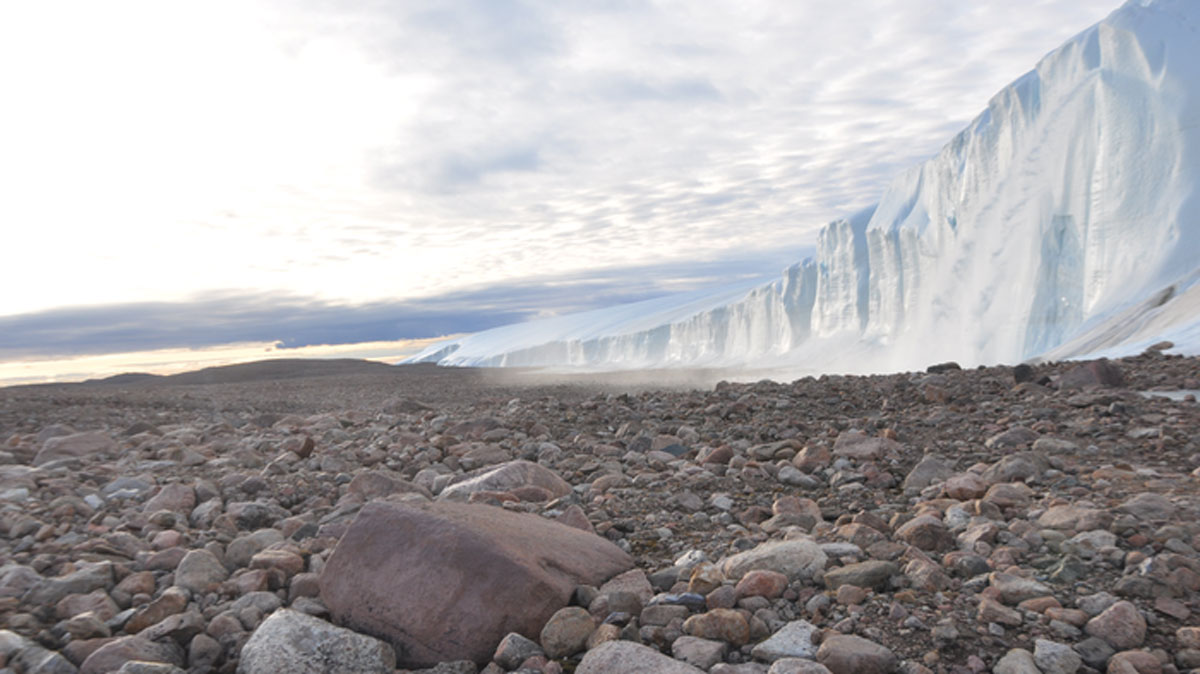In northwestern Greenland, there’s a secret hidden deep beneath glacial ice: a circular depression hundreds of meters deep and tens of kilometers wide. It’s believed to have been formed by an asteroid impact, and researchers now have analyzed bits of rock sloughed off from the structure to determine its age: about 58 million years. That’s a surprise—earlier work suggested that the impact might have occurred as recently as a few tens of thousands of years ago, during the Pleistocene, and therefore might have been responsible for the cold period known as the Younger Dryas.
What Lies Beneath
From the surface, Hiawatha Glacier looks like any other expanse of glacial ice. But in 2016, researchers flying in a converted DC-3 plane used ice-penetrating radar to peek beneath the icy mass. They discovered a bowl-shaped depression in the underlying bedrock more than 30 kilometers in diameter with an uplifted central region, geometry characteristic of an asteroid impact. On the basis of estimates of how quickly the structure was eroding, in 2018 a team suggested that the impact occurred relatively recently, during the Pleistocene.
But now researchers, including some members of the 2018 team, have pinned down the precise age of the Hiawatha impact structure. It is much, much older than previously believed—58 million or so years, which places its formation solidly in the Paleocene. To arrive at that age estimate, the scientists analyzed grains of sand and pebble-sized rocks collected just a few kilometers from the impact structure’s northern rim. This material, transported out from under the ice by flowing water, was shed from the impact structure, the team presumed.
Dating Sand and Rocks
Michael Storey, a geochronologist at the Natural History Museum of Denmark in Copenhagen and a member of the research team, led the analysis of the sand grains. Storey and his colleagues selected 50 grains, each a few millimeters in diameter, that all showed evidence of having been melted. The researchers then used argon-argon age dating, a technique that involves measuring the relative concentrations of two isotopes of argon, 39Ar and radiogenic 40Ar, to estimate the grains’ ages. Storey and his team found that the grains ranged in age, but none was younger than about 50 million years. “The 40Ar/39Ar ages hit a brick wall in the late Paleocene,” said Storey.
Gavin Kenny, a geochemist at the Swedish Museum of Natural History in Stockholm and also a team member, next led an independent analysis of two rocks from the impact structure to estimate their ages. The centimeter-scale specimens, which show signs of having experienced conditions representative of an impact, are a critical find, said Kenny. That’s because given their size, it’s more likely they’re derived from whatever cataclysm created the impact structure. Sand grains, said Kenny, “could have been scattered from somewhere else.”
“This crater is 4,500 times older than the Younger Dryas.”
Kenny and his collaborators homed in on zircon crystals, which form deep underground and incorporate tiny bits of uranium into their crystalline structure as they grow. Because uranium radioactively decays to lead over time at a known rate, the age of a zircon crystal can be inferred by measuring its relative abundances of uranium and lead. However, an asteroid impact results in extremely high temperatures and pressures, conditions that can cause zircon to recrystallize and kick out the lead within it. By measuring the ages of recrystallized zircon, it’s therefore possible to infer when an impact occurred.
The researchers analyzed 28 zircon crystals that were likely to have been recrystallized. They recovered ages as old as roughly 1.9 billion years—probably tracing the rocks that existed at the time of the impact, the team surmised—but also a cluster of ages in the Paleocene, around 58 million years ago. Given that clustering, and the fact that none of the 40Ar/39Ar–derived ages of the sand grains was younger than the Paleocene, the team concluded that the event that formed the Hiawatha impact structure occurred 58 million years ago. There’s accordingly no link whatsoever between this event and the Younger Dryas, a period of cooler-than-normal temperatures roughly 13,000 years ago that’s been tied to the rise of agriculture, said Storey. “This crater is 4,500 times older than the Younger Dryas.”
A Greenland of Rain Forest, Not Ice
Fifty-eight million years ago, northwestern Greenland would have looked nothing like it does today. For starters, there wouldn’t have been any ice, said Storey. “What the asteroid hit was a temperate rain forest.” Rather than polar bears, the landscape would have been home to hippopotamus-like creatures, alligators, and crocodiles, he said. “It was a really different world.”
“It’s not Chicxulub. It probably didn’t have a significant effect on the global climate, but it may have had interesting effects on a continental scale.”
And the destruction wrought by the impact might have been significant on a continental scale, but the effects probably weren’t felt globally, said Storey. “It’s not Chicxulub. It probably didn’t have a significant effect on the global climate, but it may have had interesting effects on a continental scale.” These results were published in March in Science Advances.
In the future, it’d be valuable to extract material directly from this impact site, said Aaron Cavosie, a planetary scientist at the Space Science and Technology Centre at Curtin University in Perth, Australia, who was not involved in the research. That means drilling through hundreds of meters of ice into bedrock, which is no small feat, he acknowledged. But doing so would provide rock samples that unambiguously trace the impact event. “That’ll provide ground-truth evidence,” said Cavosie.
—Katherine Kornei (@KatherineKornei), Science Writer

